To check out the full decklist for “Devour for Power”, look here.
Overview – “Devour for Power” is a G/U/B deck with a theme of cards that become more powerful by consuming creatures, cards, even parts of your turn. It has some really exciting fatties, and lot of creatures with abilities pertaining to your graveyard, and two of our favorite commanders in the entire deck series.
“Devour for Power” also has some great traditional Reanimator cards. Buried Alive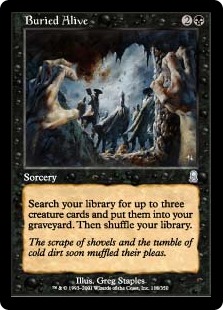
Buried Alive allows you to search your library to find up to three creatures to stock your graveyard. Nezumi Graverobber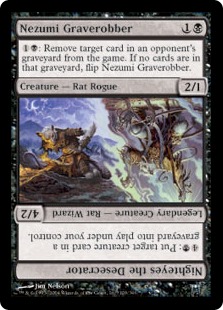
Nezumi Graverobber, Stitch Together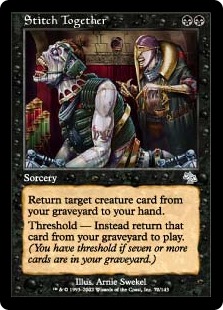
Stitch Together, Living Death
Living Death, Gravedigger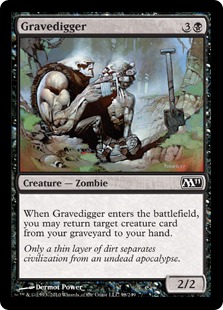
Gravedigger, and others can bring creatures from your graveyard to your hand or even the battlefield. Or, you can use Mimeoplasm and his friends Lhurgoyf 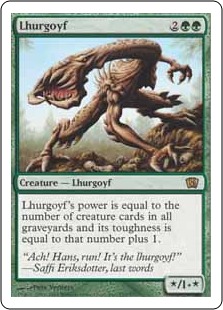
Lhurgoyf and Mortivore 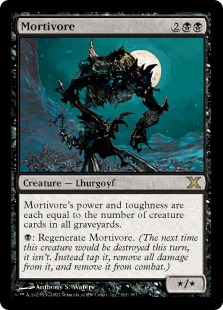
Mortivore to benefit from those of your creatures that are pushing up daisies.
Like many EDH decks, “Devour for Power” has a number of different strategies – Memory Erosion
Memory Erosion and Szadek do some milling, Scythe Specter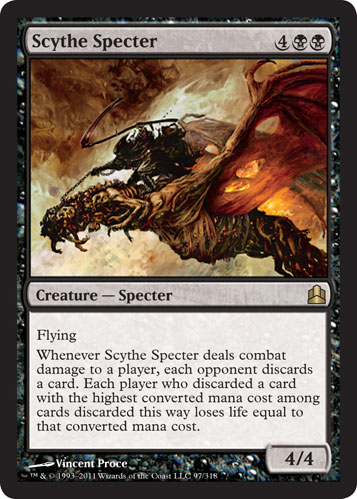
Scythe Specter is useful for some discard, there are plenty of creatures with flying and other sorts of evasion. You don’t need to use the reanimate strategy to win, especially because you’ll have plenty of mana with which to hard-cast your biggest creatures.
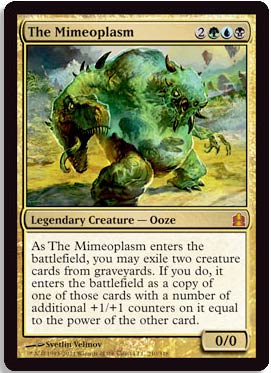 Commanders – Every one of the Commander decks has three Legends of the appropriate colors that could be used as your commander. In every case, two of the commanders are brand new cards and the third is one of the series of dragons from Planeshift. “Devour for Power” has sports what many players feels is the best line-up of commanders.
Commanders – Every one of the Commander decks has three Legends of the appropriate colors that could be used as your commander. In every case, two of the commanders are brand new cards and the third is one of the series of dragons from Planeshift. “Devour for Power” has sports what many players feels is the best line-up of commanders.
Vorosh, the Hunter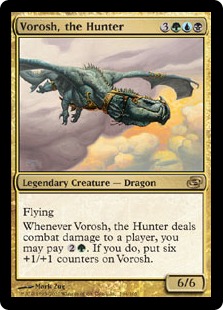
Vorosh, the Hunter is the token dragon, a 6/6 with the ability to gain six +1/+1 if he deals combat damage to an opponent for only 2G. Vorosh isn’t the most exciting of the dragons, but he does have the potential to quickly be the beefiest. While the opposing Commander decks have plenty of flying to get in his way, if you can use Vorosh’s ability just once, he’s not likely to be out-fought in the air.
The Mimeoplasm is one of the cheaper commanders out there. There are a lot of Clones out there, but Mimeoplasm really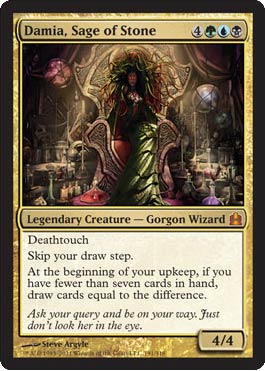 kicks things up a notch by not only copying a creature (in any graveyard) but getting a power/toughness boost equal to the power of another. This ensures that Mimeoplasm will not only be stealing any convenient abilities your opponents creatures may have, but he’s also likely to be one of the biggest creatures on the board. Even if you don’t want him to come back as your opponent’s Akroma, or your own Nezumi Graverobber, you can always find a creature with the evasion or haste necessary to swing for lethal damage.
kicks things up a notch by not only copying a creature (in any graveyard) but getting a power/toughness boost equal to the power of another. This ensures that Mimeoplasm will not only be stealing any convenient abilities your opponents creatures may have, but he’s also likely to be one of the biggest creatures on the board. Even if you don’t want him to come back as your opponent’s Akroma, or your own Nezumi Graverobber, you can always find a creature with the evasion or haste necessary to swing for lethal damage.
Finally, Damia, Sage of Stone is the commander we’re most excited to try out in “Devour for Power”. She’s basically Medusa, which is pretty awesome, and not only does she have the signature “turn to stone” ability known as deathtouch, she is going to ensure that in the later stages of the game you’ll have a handful of responses to anything your opponent can throw at you. Damia’s ability to fill up your hand every turn is pretty incredible, but the fact that she does it on your upkeep is even more incredible. She’s one card that I could see becoming a staple of animator decks, perhaps in conjunction with Jin Gitaxias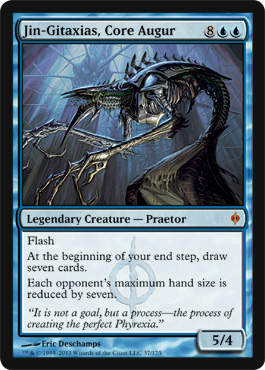
Jin Gitaxias, Core Augur.
Old Favorites – Besides the old graveyard favorites like Grave Pact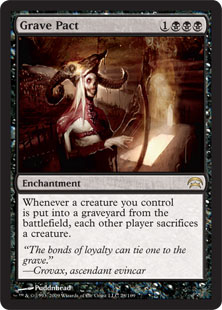
Grave Pact, “Devour for Power” brings back some great black and B/U creatures. Avatar of Woe![]()
Avatar of Woe, a perennial favorite returns here to give you one more way to empty your opponents side of the board, or to pick out your favorite graveyard-fodder in order to power up your own ghouls.
Nezumi Graverobber and Patron of the Nezumi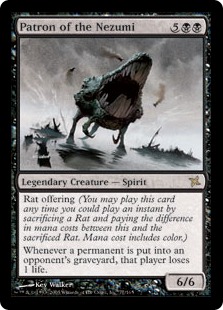
Patron of the Nezumi recall the days of rat ninjas and provide the fantastic combo of punishing your opponent when creatures hit his graveyard and then resurrecting them as your own. Also, how did the ability “Rat Offering” get by me that first time. That is one of the funniest things I have ever read on a card.
Damia’s hand-filling ability isn’t the only way to restock the shelves in “Devour for Power. Fact or Fiction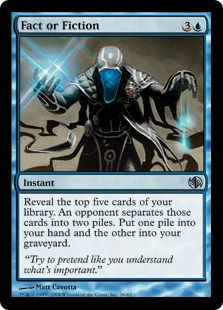
Fact or Fiction and Windfall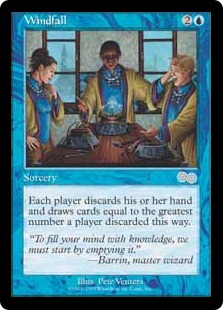
Windfall are both back and both are great additions in a setting where games take a while to get going and often leave players empty handed and waiting to top deck an answer.
Gravedigger and Eternal Witness
Eternal Witness bring creatures from your graveyard to your hand,which will help keep things moving, but Artisan of Kozilek
Artisan of Kozilek does you one better by bringing a dead guy back onto the battlefield as he comes into play.
There are also some fun old dinos like Wrexial, who allows you to play an instant or sorcery from your opponents graveyard if he successfully deals combat damage, and Szadek who mills (and grows bigger) every time he would deal combat damage to your opponent. Luckily both of them have some pretty solid evasion built in.
New Hotness – “Devour for Power”, as I’ve said already, has some great commanders, but it also has some other new cards that might interest you. Shared Trauma, a Join-Forces (anyone may pay) sorcery that allows you to put the top X cards from the top of your library into the graveyard, will not likely be helping out your opponents at all and can ensure that you have the best possible selection for your Gravedigger/Eternal Witness.
Minds Aglow, another Join Forces sorcery, allows each players to pay to draw X cards, which might seem like too much of a benefit to give to your opponents, but when you are milling with cards like Szadek and the new Riddlekeeper (your opponent mills two for every creature he chooses to attack you with) and making him discard with Scythe Scepter, perhaps refilling his hand won’t be nearly as appealing.
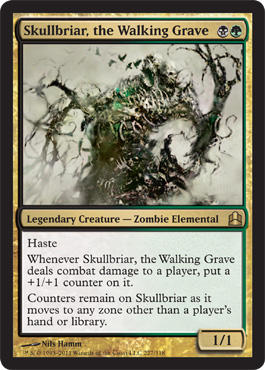
“Devour” also has some pretty powerful new creatures. Sewer Nemesis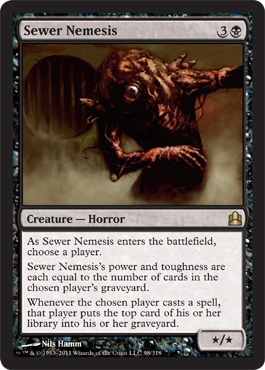
Sewer Nemesis, like Mortivore, derives his power and toughness from the size of target player’s graveyard, but he also mills that same player for one every time they cast a spell.
Skullbriar, the Walking Grave is a great early-game creature. He has haste, which hopefully will earn him one free attack, but he also grows every time he successfully damages a player. Skullbriar’s also has a special ability which (as far as I know) is completely unique: He keeps his counters in the graveyard and command zone. With as much reanimation as this deck has, he’s likely to make several return appearances, and, unless your opponent can manage to bounce him back to your hard, he’ll continue to be a threat.
Suggested Alterations – Because so many creatures in “Devour for Power” have abilities that are contingent on dealing combat damage to an opponent, it may be a good idea to add cards like Whispersilk Cloak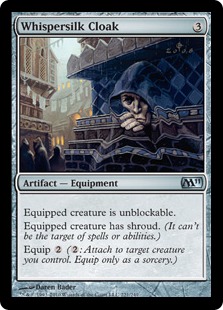
Whispersilk Cloak which give some extra evasion to ensure that your fatties actually make contact.
As I said above, “Devour” has several strategies going at once. If you wanted to take this deck apart both Szadek and Skullbriar would make good commanders of mill or reanimator deck, respectively. By the same token, you could switch out some of the less powerful commons and uncommons in this deck for stronger mill and reanimator cards like Exhume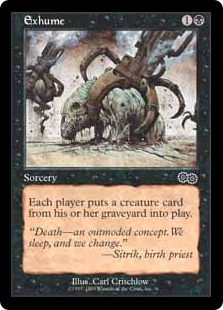
Exhume or Traumatize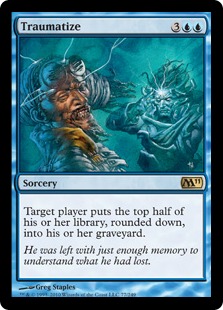
Traumatize.
Also, take out Desecrator Hag, she (?) is just creepy.
Verdict – This deck has great synergy and is bound to be a lot of fun. The cards complement each other well and the plentiful graveyard manipulation will ensure that you don’t get stalled out after you lose a commander or empty your hand.
Wizards has done a great job designing these decks and I don’t think there are any of them that will ultimately disappoint. That said, I think “Devour for Power” is going to have some very devoted fans as its component strategies are some that casual players have always loved.
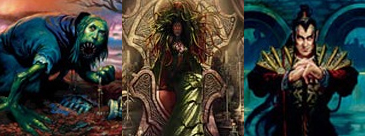
Leave a Reply